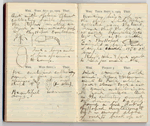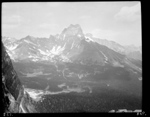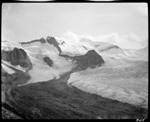
The Panoramic Photographs of Charles D. Walcott
An Exhibition of the Smithsonian Institution Archives
Smithsonian Institution Archives presents the panoramic photographs of Charles D. Walcott. These breathtaking images were taken in the Canadian Rockies, near British Columbia, Canada, in the early part of the 20th century and carry both scientific and aesthetic value.
|
Charles Doolittle Walcott was the fourth Secretary of the Smithsonian, serving as Secretary from 1907 to 1927. Dr Walcott was a paleontologist who, at the time of his appointment, was the Director of the US Geological Survey. His personal research focused on North American Cambrian fossils and he traveled widely in the United States and Canada in support of his research. In 1909, while in the Canadian Rockies near Field, British Columbia, Dr Walcott discovered what has come to be known as the Burgess Shale. Named after Burgess Pass near the location of his discovery, the shale Walcott collected contained carbonized organisms of such abundance and age that they subsequently provided the foundation for study of the Cambrian Period in Western North America. Neither Walcott nor the scientific community as a whole realized the importance of this discovery at the time, but the Burgess Shale came to be recognized as one of the most important geologic findings of the 20th century. The fossils account for Walcott’s fame, but another aspect of his research – specifically his method of photographing topographies for documentary purposes – account for a significant portion of his research data. He often took photographs of sweeping mountain views. Given the grandeur of the Canadian Rockies, it is perhaps natural that the images he captured are themselves wonderful to look at, but when one recognizes that these aesthetically pleasing images were created to provide scientific information, one sees a marriage of art and science that is both gratifying and educational.The Smithsonian Institution has the majority of Walcott’s photographic output including cellulose nitrate negatives, glass plate negatives and original prints, along with other materials documenting his life [Record Unit 7004], his work as Secretary [Record Unit 45, Record Unit 46, and Record Unit 56], and his science. The specific focus of this exhibition, however, is to highlight a few of his panoramic photographs of the Canadian Rockies. In the fifteen-plus years that Walcott traveled to the Rockies, he took over 80 large panoramic views and close to 600 smaller (5" x 20") panoramic views. The exhibition shows fifteen of the most impressive images. These photographs convey the majesty of Canada’s mountains while demonstrating both early photographic methods and the use of photography in scientific discovery. They also relate to the history of the Smithsonian and to inevitable links that our shared soil creates between Americans and Canadians. The exhibition will open to the public from 5 March – 28 May 2004 and is being held at the Canadian Embassy, in Washington DC. Specifically, the exhibition consists of fifteen panoramic photographs (up to 8 1/2 feet in length), two Burgess Shale specimens, two Walcott diaries, a Cirkut camera and instruction booklet of the type used by Walcott, and a ‘3-D’ map that shows the location in the Canadian Rockies of the images on display. The wall text includes a brief description of Walcott, his family, and his discovery, and a description of each image as Walcott recorded it. |
![Charles Walcott at Fossil Quarry, Burgess Pass, 1911 or 1912. - Click for larger image [84-16281; RU 7004, Box 44, Folder 4]](images/7004/b44f4/84-16281_0x.jpg) Charles Walcott at Fossil Quarry, Burgess Pass, 1911 or 1912 [7004/b44f4/84-16281_0] |
View of north face of Cathedral Mountain, 1910
|
||
Looking across upper
end of Hunga Glacier toward Mt. Resplendent & Lynx
Mountain, 1912 |
Mt. Assiniboine
from shore of Magog Lake, 1916 |
|
![Walcott as Secretary of the Smithsonian, 1922 - Click for larger image [000001; RU 7004, Box 44, Folder 4]](images/7004/b44f4/000001_0x.jpg)



